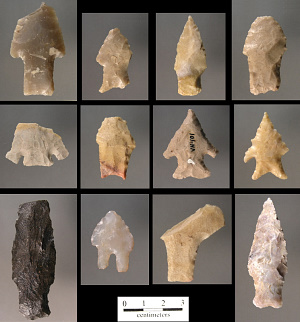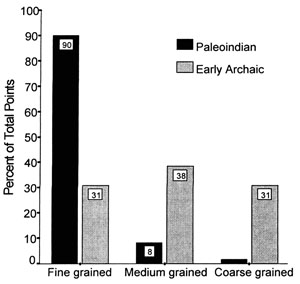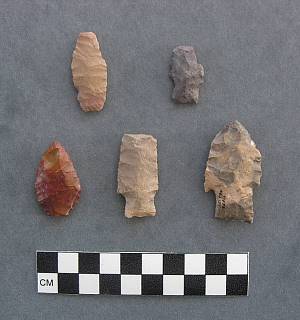Early Archaic in the Trans-Pecos
The Early Archaic period is one of the more poorly-known intervals in the Trans-Pecos. Occupation during this period is known from surface finds of projectile points, a few insubstantial deposits in rockshelters, and a small number of radiocarbon dates from hearths or rockshelter deposits. Early Archaic projectile points are relatively common in the central basins of the Trans-Pecos region and thus it remains unclear whether the lack of dated features indicates sparse use of the basins or is because features have been eroded. Of the few hearths and roasting pit features radiocarbon dated to this period, over half were buried at depths of one meter or more in alluvial deposits flanking mountain chains. These findings suggest that a large portion of the Early Archaic landscape may be buried in alluvial deposits or that occupations will be present within lower strata of rockshelters, and therefore many Early Archaic sites may not have been detected during archeological surface surveys.
Given the paucity of dated Early Archaic deposits in the Trans-Pecos, the chronology of the interval is poorly established. Current schemes for both the eastern and western Trans-Pecos areas indicate the Early Archaic begins at about 6,000 B.C. But evidence demonstrating that the period begins this late is problematic, given that the end of the Late Paleoindian period in the adjacent Southern Plains, Edwards Plateau, and Lower Pecos Canyonlands is dated to no later than 7,000-8,000 B.C. Similarly, the dating of the end of the Trans-Pecos Early Archaic is poorly established. In the western Trans-Pecos the interval is said to end at 4,000 B.C. while in the eastern area the date usually given is 3,000 B.C. These differences reflect the lack of dated deposits as well as differing definitions of what cultural markers and patterns constitute the Early Archaic.
Several aspects of technology changed during this period and provide some insights into changing adaptations and land use. Technological changes over the preceding Paleoindian Period are apparent by different hafting methods and the use of coarse-grained stone material for projectile weapons, the utilization of rock for heating elements in hearth and roasting features, and the appearance of groundstone tools. These technological changes suggest that Early Archaic peoples were seasonally mobile and organized in small bands.
The reasons underlying the rarity of Early Archaic occupations in the desert lowlands of the Trans-Pecos and northern Chihuahua are speculative at the present time. The particular form of low-intensity and highly mobile settlement and land use described above may not have left much in the way of archaeological remains. It is also possible that our knowledge of the numbers and distributions of Early Archaic sites are biased because most sites are buried and were not detected during archaeological surface surveys. However, these explanations appear faulty when considering the common presence of Paleoindian materials across the region. A more plausible explanation involves environmental changes and subsistence and hunting patterns. In contrast to the situation in the arid Trans-Pecos, Early Archaic settlements are relatively common among higher elevation or better-watered environments in adjoining areas of central and northern New Mexico and central Texas. It is likely that changing environmental conditions during the Early Archaic period may have resulted in reduced game populations in the desert lowlands, and thus Early Archaic hunters tended to avoid the desert lowlands and preferred to settle in geographic areas with greater game densities.
Contributed by Myles R. Miller
Sources
Miller, Myles R. and Nancy A. Kenmotsu
2004 Prehistory of the Jornada Mogollon and Eastern Trans-Pecos Regions of West Texas. In: The Prehistory of Texas, edited by Timothy K. Perttula, pp. 205-265. Texas A&M University Press, College Station.![]()


